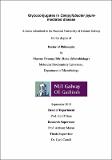| dc.description.abstract | Gram-negative bacterium Campylobacter jejuni is a major cause of gastroenteritis in humans worldwide, and the most frequent infectious trigger in patients developing Guillain-Barré syndrome (GBS). While C. jejuni is pathogenic in humans, it is a commensal in avian hosts. The mechanisms leading to C. jejuni infection of humans or persistent colonisation in chickens are not well understood, but host temperature may provide an important trigger for specific adaptation. C. jejuni and host cell-surface glycoconjugates play important play roles in infection, colonisation, and development of GBS. Initially, phenotypic characterisation of C. jejuni isolates from clinical and food sources in Ireland observed high rates of cell-surface glycoconjugate variability, as well as ganglioside mimicry, an important factor in GBS pathogenesis. Following this, comparison of glycan binding by a group of closely related C. jejuni GBS- and enteritis-related strains indicated that enteritis-related strains have higher rates of glycan-mediated adherence, potentially due to increased sialic acid recognition. Furthermore, C. jejuni strains 81116 and 81-176 were cultured at 37 and 42°C to simulate human and avian host conditions, respectively, and whole cells were profiled on neoglycoconjugate (NGC) and lectin microarrays. Analysis on the NGC array detected only minor differences between the strains and growth temperatures, while, on the lectin microarray the profiles of both strains varied considerably and were distinguishable at both temperatures, due to difference in cell-surface glycoconjugate expression. Subsequently, a differential pro-inflammatory response was observed in chicken cells stimulated with lipooligosaccharide (LOS) isolated from C. jejuni 81116 grown at 37 and 42°C. Chicken embryonic fibroblast (CEF) cells responded differently to the LOS types, in which 37°C LOS, but not 42°C LOS, induced pro-inflammatory gene expression. Mass spectrometry analysis determined that this was due to changes in the ratio of lipid A backbone disaccharide variants between the temperatures. Moreover, C. jejuni capsular polysaccharide (CPS) was not found to be immunogenic to chicken cells in vitro. Thus, CPS expression as well as temperature-related lipid A variation by C. jejuni, may be important in chicken immune evasion or subversion, and contribute to persistent colonisation. Finally, a proposed structure for C. jejuni 81116 LOS was elucidated, which contained a novel N-formyl modified hexose. | en_US |


